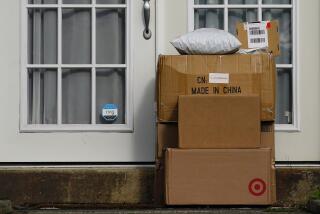How to Help Deliverers Avoid Bum Wrap
- Share via
WASHINGTON — Hundreds of thousands of holiday gifts are about to be let loose in the mails, and the Postal Service, United Parcel Service and other delivery agencies are preparing for their busiest season.
Selected with thoughtfulness and accompanied by best wishes, many gifts arrive battered or broken each year. Some never make it at all. Insuring the parcel can help in recovery if it is lost or damaged.
Although people like to blame the deliverer, the fault at times lies elsewhere. Delivery problems can occur if wrappings fail to protect the gift or address labels get lost or smear.
Consumers can improve the chances of safe delivery by following some suggestions by the U.S. Postal Service:
* Addressing:
Any parcel should be clearly marked with the address of sender and recipient, including the ZIP code.
Use indelible ink to prevent smearing, or type the address on a label. The address should be easily readable at arm’s length.
Place another piece of paper inside with both addresses and a list of the contents of the package. That way, if the parcel is damaged in shipping, it can still be delivered and the clerks will be able to identify the contents of the package and keep them together.
Appropriate markings such as “Fragile,” “Perishable” and “Do Not Bend” should be placed in three spots: Above the address, below the postage and on the back of the package.
But remember that those markings do not guarantee special care; the package must still be wrapped properly.
* Mailing Containers:
Fiberboard boxes are strong enough to ship most parcels. These are the boxes readily available in stores. Most contain a mark specifying the strength.
The important numbers are the “Bursting Test,” which indicates the ability of the box to resist breaking, and the “Gross Weight Limit,” which tells the amount the box can properly hold.
The weight is easy to determine.
For the bursting test, items that weigh 20 pounds or less need a box rated at 125 pounds. For 40-pound parcels, get a box rated at 175 pounds burst strength. Loads of 65 pounds need a box rated at 200 pounds burst strength.
High-density items--such as hardware or auto parts--need stronger boxes regardless of actual weight.
Containers other than fiberboard are also appropriate in many cases--such as reinforced bags, wooden boxes, tubes and so forth. This, of course, depends on the size, shape, weight and other characteristics of the item being sent.
The container should be large enough to include the items being mailed plus cushioning, but not so large as to permit shifting or jiggling.
Liquids and powders should be sent in leakproof containers and items that have odors in containers that are impermeable.
* Cushioning:
Cushioning distributes and absorbs shocks and vibrations and helps prevent contents of a parcel from shifting.
When several items are packaged in the same container they need to be cushioned from each other and from outside forces. And even items in their own box need some cushioning. Heavy items should be securely braced.
Many types of suitable cushioning are available including polystyrene, shredded or rolled newspaper, bubble plastic or fiberboard containers. Some people have also been known to use plastic bags filled with popcorn, rolled up towels and other similar materials.
* Wrapping:
If the box itself is an adequate container, the Postal Service prefers that wrapping paper be omitted altogether. But strong wrapping paper may be used if needed.
Packages should be sealed with filament-reinforced tape whenever possible. Twine and cord are allowed, but postal officials prefer that these not be used as they tend to catch and bind in automatic processing equipment.
More to Read
Sign up for The Wild
We’ll help you find the best places to hike, bike and run, as well as the perfect silent spots for meditation and yoga.
You may occasionally receive promotional content from the Los Angeles Times.





